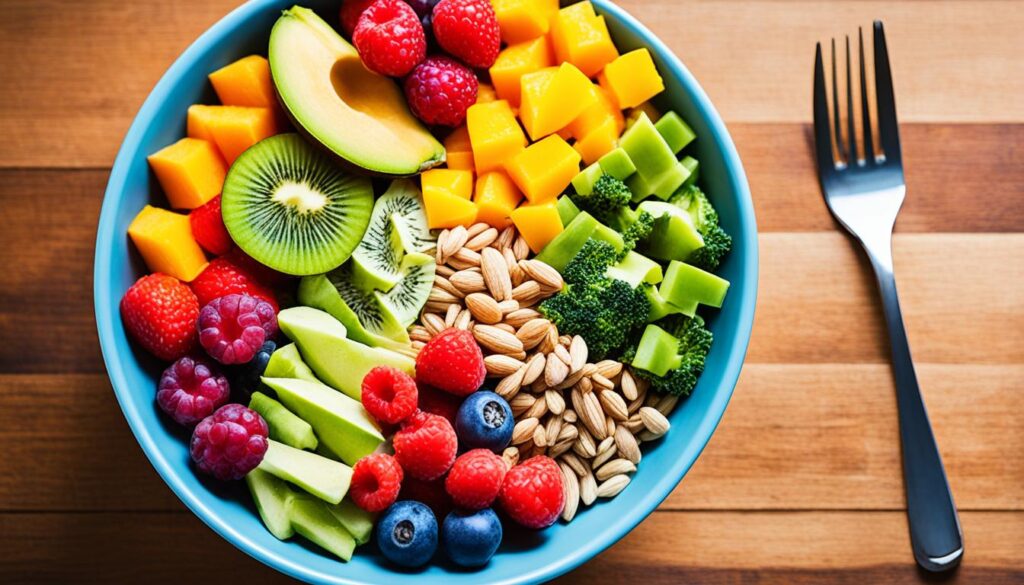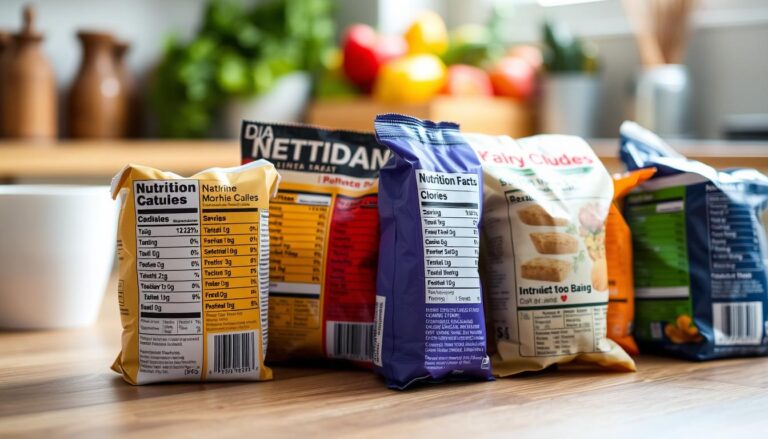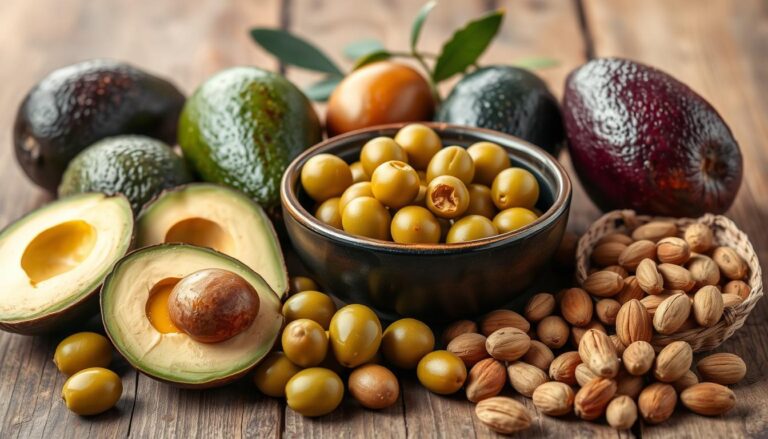Are you tired of carrying around that stubborn midsection? Wondering what the best way to get rid of belly fat is? We’ve got the secrets to help you burn fat and improve your health.
Key Takeaways
- Visceral fat poses serious health risks, so targeting belly fat is crucial for your well-being.
- A combination of fat burning exercises, weight loss diet, and lifestyle changes is the key to sustainable belly fat reduction.
- Abdominal workouts alone won’t spot-reduce fat, but they can help tone and define your midsection.
- Metabolism boosters like HIIT training and intermittent fasting can help you achieve a calorie deficit for visceral fat loss.
- Consistency and variety in your fitness routine are essential for long-term success in losing belly fat.
The Importance of Losing Belly Fat
Losing extra pounds around your waist isn’t just for looks. It’s key for your health. The fat under your skin, called subcutaneous fat, is easy to see. But the deeper visceral fat around your organs is a bigger worry.
Visceral Fat: The Hidden Health Risk
Visceral fat raises the risk of diabetes, heart disease, PCOS, and some cancers. Even a small amount of visceral fat can be harmful to your health. Losing just 5-10% of your body weight can make a big difference. So, focusing on losing fat overall is key for your health.
Johns Hopkins researchers found that a low-carb diet led to more weight loss than a low-fat diet after six months. People on the low-carb diet lost about 10 pounds more, ending up with 28.9 pounds lost. The low-fat diet resulted in 18.7 pounds lost. Both diets led to losing lean tissue and fat, but the low-carb diet had more fat loss.

“For improved health, it’s recommended that women maintain a waistline of less than 35 inches and men less than 40 inches. Men with a waist measurement of more than 40 inches (102 centimeters) are at risk of having an unhealthy amount of belly fat.”
By changing your lifestyle and focusing on weight loss, fat blasting, metabolism boosting, and abdominal toning, you can improve your health. Understanding the risks of visceral fat is the first step in taking control of your health.
Aerobic Exercise: Get Your Heart Pumping
Aerobic exercise is great for burning calories and losing belly fat. Activities like brisk walking, jogging, cycling, swimming, and sports increase your metabolism. Try to do at least 150 minutes of moderate-intensity cardio each week for best results.
To burn more fat, keep your heart rate between 70-85% of your max heart rate. This zone is key for fat loss. For a 35-year-old, this means a heart rate of 130-157 bpm.
Interval training, like walking and running, is effective for burning calories and improving heart health. Being consistent and gradually increasing exercise intensity is important for lasting weight loss.

Start your workout with 10 minutes of light cardio, like jumping jacks or jump rope. This gets your body ready for harder exercises. Mixing fat-burning exercises and HIIT training in your routine helps you create a calorie deficit. This is key for a slimmer, healthier midsection.
“Aerobic exercise is the foundation for a healthy lifestyle and can help you achieve your weight loss goals. The key is finding activities you enjoy to stay motivated and consistent.”
Strength Training: Build Muscle, Burn Fat
Strength training is key for losing weight, not just for abs. It helps build muscle, which burns more calories than fat, even when you’re not moving. This can help you lose belly fat.
A 2020 study found that you can lose fat and gain muscle at the same time. But, more research is needed to see how this works for different people.
To lose fat and build muscle, do 2-3 strength training sessions a week. Use exercises like Pilates, kettlebells, pushups, squats, and resistance training. These exercises work many muscles at once, helping you burn calories more efficiently.
The study said to do compound exercises with short breaks to build muscle and burn calories. For beginners, sprints are a great way to burn fat.
Getting enough rest is important to avoid getting hurt or overtraining. The study recommended eating less and trying intermittent fasting to help with fat loss and muscle gain.

As we get older, we lose muscle and gain fat, especially around the waist. Strength training can help stop this. It leads to a leaner body and better health.
Reduce Added Sugar Consumption
Eating too much added sugar can lead to weight gain and belly fat. It’s not just sweets like candy and soda that have sugar. Many foods and drinks have hidden sugars.
Sneaky Sources of Added Sugars
Added sugars are in foods like cereals, protein bars, and even condiments. It’s key to read labels well. Look for names like corn syrup, high-fructose corn syrup, and agave that mean added sugar.
Experts say added sugars should be less than 10% of daily calories. For men, that’s about 9 teaspoons (38 grams) a day. Women should aim for 6 teaspoons (25 grams). But, Americans often eat 22 to 28 teaspoons a day, more than twice the limit.
Cutting back on these high-sugar foods and drinks helps lose belly fat and boosts health.
| Sneaky Sources of Added Sugars | Average Sugar Content |
|---|---|
| 12-ounce can of soda | 39 grams (9 teaspoons) |
| Flavored yogurt | 19 grams (4.75 teaspoons) |
| Granola bar | 12 grams (3 teaspoons) |
| Ketchup (2 tablespoons) | 8 grams (2 teaspoons) |
“Reducing added sugars is one of the most effective ways to lose weight and reduce belly fat. It’s essential to be aware of hidden sources of sugar in our diets.”
What burns the most belly fat?
Losing belly fat isn’t easy and there’s no single solution. To burn the most belly fat, you need a mix of lifestyle changes. While no single exercise or food targets belly fat, a mix of cardio, strength training, diet changes, and healthy habits helps with fat loss.
Cardio exercises like walking, jogging, cycling, or swimming burn calories and help lose fat, including belly fat. Aim for 225 to 420 minutes of exercise each week to lose at least 5% of your body weight.
Strength training is key in fighting belly fat. It builds muscle, which increases your metabolism and burns more calories, even when you’re resting. Add exercises like weightlifting, resistance training, or bodyweight exercises to your routine.
- Reduce added sugar intake, as high sugar consumption is linked to increased abdominal fat.
- Increase your fiber intake, as studies show that higher fiber intake is associated with lower belly fat.
- Prioritize protein-rich foods, as research suggests a correlation between high protein intake and lower abdominal fat.
- Limit alcohol consumption, as heavy alcohol use is associated with the development of excess fat around the waist.
- Get 7-8 hours of quality sleep each night, as poor sleep is linked to more belly fat.
- Manage stress levels, as high cortisol can increase appetite and drive abdominal fat storage.
There’s no quick fix for belly fat. The best way to get a flat midsection is through a mix of exercise, diet, and lifestyle changes. This approach improves health overall.

“The most effective approach to losing belly fat is to focus on overall fat loss through a combination of cardio, strength training, dietary changes, and lifestyle factors.”
Fiber and Protein: Stay Full, Lose Fat
Getting to a healthy weight and losing belly fat needs a full approach. This includes eating foods rich in fiber and protein. Adding these nutrients to your weight loss diet helps you feel full, reduces hunger, and boosts your metabolism.
Foods high in fiber like lentils, beans, whole grains, and berries keep you feeling full. This can help you eat less and lose weight. Eating more soluble fiber can lower the risk of gaining belly fat by 3.7%. It also helps good gut bacteria grow, which is good for your health and losing belly fat.
Protein is key for weight loss and fat burning. Eating enough protein from lean meats, dairy, eggs, and plants keeps you full and helps build muscle. This can increase your metabolism. Adding high-protein foods to your meals and snacks can greatly help your weight loss diet and belly fat reduction goals.
“A diet rich in high-protein foods such as eggs, fish, seafood, legumes, nuts, meat, and dairy results in less abdominal fat, increased satiety, and improved metabolic function.”
Using fiber and protein as the base of your diet can help you stay full, lose fat, and reach your weight loss and belly fat reduction goals. A balanced diet is key to boosting your metabolism naturally.

Limit Alcohol and Late-Night Eating
When focusing on belly fat loss, think about how much alcohol you drink and when you eat at night. Drinking too much alcohol and eating late can lead to more belly fat. This can also make it harder to get a flat stomach.
Alcohol has lots of empty calories and can make you eat more. Studies show that drinking a lot can increase belly fat. Cutting down on alcohol helps you eat fewer calories and helps with belly fat loss.
Eating late can also lead to extra fat storage. Eating at the same time every day and skipping late snacks helps avoid this. Planning your meals ahead helps you make better choices and avoid late-night snacks.
“A 2023 study in BMC Public Health highlighted that changing posture and taking movement breaks during the workday for individuals who have sedentary jobs was associated with a healthier BMI.”
Working on your alcohol use and eating habits at night can really help with reducing belly fat and reaching your flat stomach goals. Being consistent and balanced is important for lasting belly fat loss.
Meal Planning and Sleep: Lifestyle Factors
Getting a flat stomach and losing weight takes more than just exercise and a good diet. Meal planning and enough sleep are key to managing weight. They help you stay on track with your goals.
Adequate Sleep for Weight Management
Sleeping 7-8 hours a night is vital for losing weight. Not getting enough sleep can mess with your hunger hormones. This can lead to eating more and gaining belly fat.
Research shows that sleeping less than seven hours a night can make you more likely to become obese. Getting enough sleep helps your core workouts and flat stomach efforts.
Planning your meals with whole grains, lean proteins, healthy fats, and veggies is also key. This way, you’re always ready with healthy food. It stops you from choosing unhealthy snacks when you’re hungry.
| Benefit | Description |
|---|---|
| Time-Saving | Meal prepping makes cooking easier and less stressful by planning meals ahead. |
| Portion Control | Planning meals helps you control how much you eat. This prevents overeating and supports healthier eating. |
| Nutrient-Dense | Well-planned meals with whole foods give you the nutrients you need for losing weight and staying healthy. |
Focus on getting enough sleep and planning your meals well. This combo will help you in your weight loss journey. It will also help you reach your flat stomach and core workouts goals.
Stress Management: The Mind-Body Connection
Trying to lose weight can be tough, and stress often gets overlooked. Stress can really affect how well you can lose belly fat and keep a healthy weight. The body releases cortisol, a “stress hormone,” when stressed. This hormone can change your appetite, metabolism, and how your body stores fat.
Stress eating is a common way people cope, but it can lead to gaining weight. Foods eaten during these times are often high in calories and low in nutrients. Feeling happy, sad, anxious, or angry can also change how you eat and move, leading to weight changes. It’s key to manage stress well for weight loss and belly fat loss.
Stress-Reducing Techniques
- Incorporate mindfulness practices like meditation or yoga to help regulate stress levels and promote a sense of calm.
- Engage in regular physical activity, as exercise can help reduce cortisol levels, improve mood, and trigger the release of endorphins.
- Prioritize getting adequate sleep, as sleep deprivation disrupts hormone balance, increasing ghrelin (hunger hormone) and decreasing leptin (satiety hormone), leading to overeating and weight gain.
- Practice mindful eating by tuning into hunger and fullness cues, helping to break free from emotional eating patterns.
By focusing on the mind-body connection and using stress management, you can help your weight loss and belly fat loss efforts. This can improve your overall health and well-being.
| Stress-Related Factors Impacting Weight | Impact on Weight |
|---|---|
| Cortisol (Stress Hormone) | Higher long-term cortisol levels are strongly related to having abdominal obesity, as per a 2018 review study. |
| Sleep Deprivation | Adults ages 18 to 65 years old who get less than 6 hours or more than 9 hours of sleep develop more visceral fat. |
| Emotional Eating | Stress eating, a common coping mechanism, can lead to weight gain over time due to consuming high-calorie, low-nutrient foods. |
Managing stress is important for both your physical and mental health. By adding stress-reducing activities to your day, you can make your weight loss journey better. This leads to a healthier and more balanced life.
Conclusion
Shedding belly fat needs a mix of exercises and diet changes. Spot exercises alone won’t cut it. Instead, focus on losing fat overall.
Being patient and consistent is key for lasting weight loss. Slow, steady changes in your diet and exercise can lead to a flatter stomach. Adding good sleep and managing stress also helps.
So, start your journey to what burns the most belly fat, belly fat loss, reduce belly fat, and get that flat stomach. Your body will be grateful!





